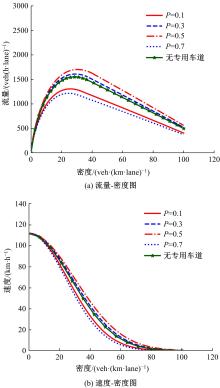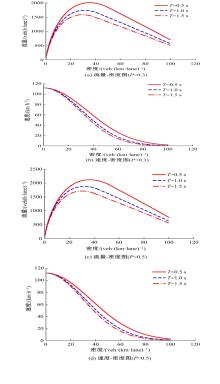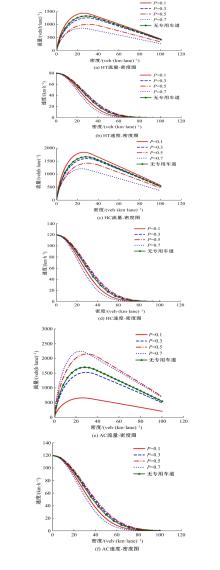吉林大学学报(工学版) ›› 2023, Vol. 53 ›› Issue (7): 2043-2052.doi: 10.13229/j.cnki.jdxbgxb.20211007
• 交通运输工程·土木工程 • 上一篇
设置自动驾驶小客车专用车道的六车道高速公路交通流特性
- 1.长沙理工大学 公路养护技术国家工程实验室,长沙 410114
2.长沙理工大学 交通运输工程学院,长沙 410114
3.美国威斯康辛大学麦迪逊分校 土木与环境工程系,麦迪逊 53706,美国
Traffic flow characteristics of six⁃lane freeways with a dedicated lane for automatic cars
Liu YANG1,2( ),Chuang-ye WANG1,2,Meng-yan WANG1,2,Yang CHENG3
),Chuang-ye WANG1,2,Meng-yan WANG1,2,Yang CHENG3
- 1.National Engineering Laboratory of Highway Maintenance Technology,Changsha University of Science & Technology,Changsha 410114,China
2.School of Traffic and Transportation Engineering,Changsha University of Science & Technology,Changsha 410114,China
3.Department of Civil and Environmental Engineering,University of Wisconsin?Madison,Madison 53706,United States
摘要:
为解决未来高速公路上自动驾驶小客车(AC)、人类驾驶小客车和人类驾驶大货车混行所带来的安全和效率问题,研究了在六车道高速公路上设置AC专用车道的方法及其对交通流的影响。提出了内侧式AC专用车道的隔离方式和出入口布设方法。基于VISSIM建立了包含入口和出口匝道的高速公路模型、车辆模型和驾驶行为模型,高速公路设计速度取120 km/h,货车混入率取0.2。通过模拟实验,研究了设置内侧式AC专用车道后AC渗透率和AC安全车头时距对交通流特性的影响,探讨了AC专用车道对各车型和各车道运行的影响。结果表明:AC渗透率对交通流特性的影响是显著的和非线性的,存在一个最优AC渗透率,使设置了AC专用车道的高速公路具有最大的通行能力、临界密度和平均速度;AC安全车头时距对交通流特性的影响是非线性的,AC安全车头时距越小,对高速公路通行能力的改善效果越显著;AC渗透率对各车型和各车道的流量和平均速度都有显著影响,对AC流量和内侧车道流量的影响最大。
中图分类号:
- U412
| 1 | Bansal P, Kockelman K M. Forecasting Americans' long-term adoption of connected and autonomous vehicle technologies[J]. Transportation Research Part A, 2017, 95: 49-63. |
| 2 | Ye L, Yamamoto T. Impact of dedicated lanes for connected and autonomous vehicle on traffic flow throughput[J]. Physica A: Statistical Mechanics and its Applications, 2018, 512(11): 588-597. |
| 3 | 魏修建, 胡荣鑫, 苏航, 等. 双车道自动-手动驾驶汽车混合交通流博弈模型及其仿真[J]. 系统工程, 2018, 36(11): 97-104. |
| Wei Xiu-jian, Hu Rong-xin, Su Hang, et al. Mixed traffic flow game model and simulation of automatic and manual driving vehicle in two-lane condition[J]. Systems Engineering, 2018, 36(11): 97-104. | |
| 4 | Chen Shu-kai, Wang Hua, Meng Qiang. Designing autonomous vehicle incentive program with uncertain vehicle purchase price[J]. Transportation Research Part C, 2019, 103(6): 226-245. |
| 5 | Lin Xiao, Wang Meng, Arem B V. Traffic flow impacts of converting an HOV lane into a dedicated CACC lane on a freeway corridor[J]. IEEE Intelligent Transportation Systems Magazine, 2020, 12(1): 60-73. |
| 6 | Chen Zhi-bin, He Fang, Zhang Li-hui, et al. Optimal deployment of autonomous vehicle lanes with endogenous market penetration[J]. Transportation Research Part C, 2016, 72(11): 143-156. |
| 7 | Ivanchev J, Knoll A, Zehe D, et al. Potentials and implications of dedicated highway lanes for autonomous vehicles[J]. arXiv: Multiagent Systems, 2017: 1-12. |
| 8 | Ma Ke, Wang Hao. Influence of exclusive lanes for connected and autonomous vehicles on freeway traffic flow[J]. IEEE Access, 2019, 7: 50168-50178. |
| 9 | Yu H, Tak S, Park M, et al. Impact of autonomous-vehicle-only lanes in mixed traffic conditions[J]. Transportation Research Record, 2019, 2673(9): 430-439. |
| 10 | 孙玲, 张静, 周瀛, 等. 车路协同环境下自动驾驶专用车道入口区域设计[J]. 公路交通科技, 2020, 37(): 122-129. |
| Sun Ling, Zhang Jing, Zhou Ying, et al. Entrance area design of autonomous driving lane under vehicle-road collaboration environment[J]. Highway Traffic Technology, 2020, 37(Sup.1): 122-129. | |
| 11 | 秦严严, 王昊, 王炜, 等. 自适应巡航控制车辆跟驰模型综述[J]. 交通运输工程学报, 2017, 17(3): 121-130. |
| Qin Yan-yan, Wang Hao, Wang Wei, et al. Review of car-following models of adaptive cruise control[J]. Journal of Traffic and Transportation Engineering, 2017, 17(3): 121-130. | |
| 12 | Li Tie-nan, Chen Dan-jue, Zhou Hao,et al. Car-following behavior characteristics of adaptive cruise control vehicles based on empirical experiments[J]. Transportation Research Part B, 2021, 147: 67-91. |
| 13 | Treiber M, Hennecke A, Helbing D. Congested traffic states in empirical observations and microscopic simulations[J]. Physical Review E, Statistical Physics, Plasmas, Fluids, and Related Interdisciplinary Topics, 2000, 62(2): 1805-1824. |
| 14 | 蒋阳升, 王思琛, 高宽, 等. 混入智能网联车队的混合交通流元胞自动机模型[J]. 系统仿真学报, 2021,34(5): 1-8. |
| Jiang Yang-sheng, Wang Si-chen, Gao Kuan, et al. Cellular automata model of mixed traffic flow composed of intelligent connected vehicles' platoon[J]. Journal of System Simulation, 2021,34(5):1-8. | |
| 15 | 陈永, 张薇. 高速跟驰交通流动力学模型研究[J]. 物理学报, 2020, 69(6): 136-148. |
| Chen Yong, Zhang Wei. Dynamic model of high speed following traffic flow[J]. Acta Physica Sinica, 2020, 69(6): 136-148. | |
| 16 | Ma Xiao-liang. A neural-fuzzy framework for modeling car-following behavior[C]∥IEEE International Conference on Systems, Man and Cybernetics, Taipei, China, 2006: 1178-1183. |
| 17 | Wiedemann R. Simulation of Road Traffic in Traffic Flow[R]. Karlsruhe: University of Karlsruhe(TH), 1974. |
| 18 | 王殿海, 金盛. 车辆跟驰行为建模的回顾与展望[J]. 中国公路学报, 2012, 25(1): 115-127. |
| Wang Dian-hai, Jin Sheng. Review and outlook of modeling of car following behavior[J]. China Journal of Highway and Transport, 2012, 25(1): 115-127. | |
| 19 | 徐桃让, 姚志洪, 蒋阳升, 等. 智能网联车环境下考虑反应时间影响的基本图模型[J]. 公路交通科技, 2020, 37(8): 108-117. |
| Xu Yao-rang, Yao Zhi-hong, Jiang Yang-sheng, et al. Fundamental diagram model of considering reaction time in environment of intelligent connected vehicles[J]. Journal of Highway and Transportation Research and Development, 2020, 37(8): 108-117. | |
| 20 | 王雪松, 孙平, 张晓春, 等. 基于自然驾驶数据的高速公路跟驰模型参数标定[J]. 中国公路学报, 2020, 33(5): 132-142. |
| Wang Xue-song, Sun Ping, Zhang Xiao-chun, et al. Calibrating car-following models on freeway based on naturalistic driving data[J]. China Journal of Highway and Transport, 2020, 33(5): 132-142. | |
| 21 | 李志伟. 智能网联车辆与普通车辆混合车流交通状态估计方法研究[D]. 南京: 东南大学交通运输工程学院, 2017. |
| Li Zhi-wei. Study on methods of traffic estimation under connected and autonomous vehicles and manual vehicles mixed traffic flow[D]. Nanjing: School of Transportation Southeast University, 2017. |
| [1] | 何永明,陈世升,冯佳,万亚楠. 基于高精地图的超高速公路虚拟轨道系统[J]. 吉林大学学报(工学版), 2023, 53(7): 2016-2028. |
| [2] | 郑睢宁,何锐,路天宇,徐紫祎,陈华鑫. RET/胶粉复合改性沥青制备及其混合料性能评价[J]. 吉林大学学报(工学版), 2023, 53(5): 1381-1389. |
| [3] | 李艳波,柳柏松,姚博彬,陈俊硕,渠开发,武奇生,曹洁宁. 考虑路网随机特性的高速公路换电站选址[J]. 吉林大学学报(工学版), 2023, 53(5): 1364-1371. |
| [4] | 魏海斌,韩栓业,毕海鹏,刘琼辉,马子鹏. 智能感知道路主动除冰雪系统及实验技术[J]. 吉林大学学报(工学版), 2023, 53(5): 1411-1417. |
| [5] | 杨帆,李琛琛,李盛,刘海伦. 温缩作用下双层连续配筋混凝土路面配筋率设计参数对比分析[J]. 吉林大学学报(工学版), 2023, 53(4): 1122-1132. |
| [6] | 关博文,邸文锦,王发平,吴佳育,张硕文,贾治勋. 干湿循环与交变荷载作用下混凝土硫酸盐侵蚀损伤[J]. 吉林大学学报(工学版), 2023, 53(4): 1112-1121. |
| [7] | 刘状壮,张有为,季鹏宇,Abshir Ismail Yusuf,李林,郝亚真. 电热型融雪沥青路面传热特性研究[J]. 吉林大学学报(工学版), 2023, 53(2): 523-530. |
| [8] | 罗瑞发,郝慧君,徐桃让,顾秋凡. 考虑智能网联车队强度的混合交通流基本图模型[J]. 吉林大学学报(工学版), 2023, 53(2): 405-412. |
| [9] | 魏海斌,马子鹏,毕海鹏,刘汉涛,韩栓业. 基于力学响应分析方法的导电橡胶复合路面铺装技术[J]. 吉林大学学报(工学版), 2023, 53(2): 531-537. |
| [10] | 时成林,王勇,吴春利,宋文祝. 路堤挡土墙主动土压力计算方法修正[J]. 吉林大学学报(工学版), 2022, 52(6): 1394-1403. |
| [11] | 郭庆林,刘强,吴春利,李黎丽,李懿明,刘富春. 导电沥青及混合料裂缝局部温度场及愈合效果[J]. 吉林大学学报(工学版), 2022, 52(6): 1386-1393. |
| [12] | 姚玉权,仰建岗,高杰,宋亮. 基于性能-费用模型的厂拌再生沥青混合料优化设计[J]. 吉林大学学报(工学版), 2022, 52(3): 585-595. |
| [13] | 夏全平,高江平,罗浩原,张其功,李志杰,杨飞. 用于高模量沥青砼的复合改性硬质沥青低温性能[J]. 吉林大学学报(工学版), 2022, 52(3): 541-549. |
| [14] | 叶奋,胡诗园. 考虑旧水泥路面接缝传荷能力的超薄罩面力学特性[J]. 吉林大学学报(工学版), 2022, 52(11): 2636-2643. |
| [15] | 于晓贺,罗蓉,柳子尧,黄婷婷,束裕. 沥青路面典型裂缝湿度场数值模拟[J]. 吉林大学学报(工学版), 2022, 52(10): 2343-2351. |
|
||













